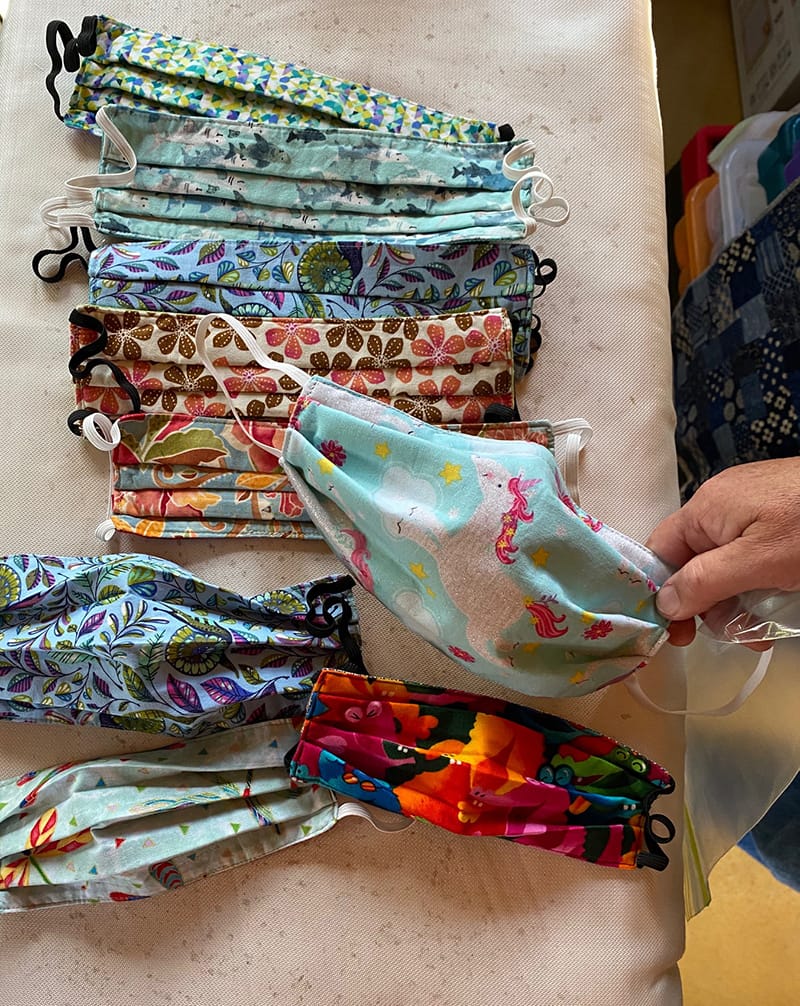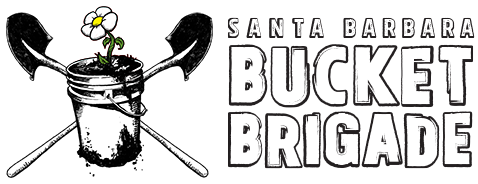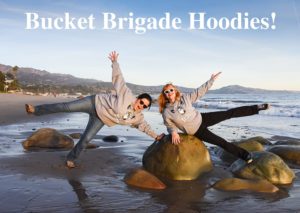The Bucket Brigade
“Most Mask Maker Challenge”
Who is the Rockstar of Sewing in Santa Barbara County? Let’s find out!
The Centers for Disease Control and Prevention (CDC) recommends that people wear masks in public to slow the spread of coronavirus. Most people don’t have masks. We can do something about it — together.
 This is a call to action!
This is a call to action!
- Do you have sewing skills and time on your hands?
- Would you like to win cool prizes while helping keep the community safe, all from the safety of your home?
It’s easy! You sew masks at home. We pick up and deliver them to those in need. We bring you free material for more masks. We give you prizes for hitting mask-making targets. Let’s find out how many masks we can make together!
HOW TO PARTICIPATE
- Sign up here
- Sew 100% cotton masks using the CDC-provided pattern below.
- Put them in a bag and schedule a pickup using our handy mask pickup form.
PICK UP
- Schedule Pick Up Here
- We will pick them up from your porch and, if you need some, we’ll bring you material for more masks. Plus, there are prizes based on how many masks you’ve made!
- Make more masks!
- Win more prizes!
- Go for the Bucket Brigade Sewing Championship of Santa Barbara County!
- Whoever sews the most masks wins the GRAND PRIZE! (see below)
- Challenge your friends and neighbors
- Send us tips, updates, and photos to share on social media
GRAND PRIZE
GRAND PRIZE FOR THE “MOST MASK MAKER OF THE MONTH”
- $300 Trader Joe’s gift certificate!
- Your own ”Santa Barbara Sewing Superhero” page on our website!
- Victory announcement featuring you (and your sewing awesomeness) in the Santa Barbara Independent!
- Championship bragging rights
- A trophy from Santa Barbara Trophy
- Huge box of organic produce from Roots Organic Farm
- A complete skateboard from Powell Peralta
Most Mask Maker Competition RULES:
- The purpose of this competition is to make a lot of homemade masks quickly.
- The contest starts on April 7 and ends at 5 p.m. on April 30.
- We only count masks that are picked up by us or delivered to the Bucket Brigade and that comply with the CDC-provided pattern. If you make masks and take them somewhere else that’s okay, but we won’t count them for the competition.
- We will do our absolute best to keep an accurate count of masks from each maker.
- The maker of the most masks that are picked up by or delivered to the Santa Barbara Bucket Brigade before April 30 at 5 p.m. will win the grand prize.
- “Piece Prizes” will be available while supplies last. We have a good supply of these items, but we have no idea how many people will compete.
- There will only be one grand prize.
- The grand prize winner will be announced on May 4th at 5 PM.
Sewn Cloth Face Covering Instructions
Materials & Tools — Here’s what you need:
- Two 6- by 10-inch rectangles of preshrunk 100% cotton fabric.
- Two 12-inch lengths of ¼-inch elastic.
- Needle and thread (or bobby pin).
- Scissors.
- Sewing machine.
- Iron.

Tutorial

REVISED Instructions-Please read this first:
- WASH & DRY FABRIC
- Cut and iron two 6- by 10-inch rectangles of cotton fabric. Use tightly woven 100% cotton, such as quilting fabric or cotton sheets. Stack the two rectangles; you will sew the mask as if it was a single piece of fabric.

- Fold over the long sides ¼-inch and hem and stitch down. Then fold the double layer of fabric over ½-inch along the short sides and stitch down.

- Run a 12-inch length elastic through the wider hem on each side of the mask. These will be the ear loops. Use a large needle or bobby pin to thread it through. Knot the ends tight — make sure the ear loops are as long as possible.

- Tuck the knots inside the hem to keep it from slipping.
**MASK UPDATE: Please stitch the ear loops in the hem and stitch in place at the TOP of the ear loop only. Thank you! Each week…a little better.
- CRITICAL STRETCH TEST –> Please do this test on your first mask to see if the ear loops are long enough.
If you can’t stretch the mask 23” wide –> you need longer ear loops!

- Put your finished masks back in the bag with your name, and go to “Most Mask Maker Pickup Request Form” at https://forms.gle/fBV5DYfFJS6RU1SWA
- On pickup day, put your bag of finished masks on the porch (or at the spot indicated in your special instructions. Make sure to include your name and number of masks!
Our rule: “No finished masks to pick up, no additional mask materials delivered.”
MORE MATERIALS: If you are making masks faster than we are bringing materials – email [email protected] and we will set up a bigger delivery package for you.
Thank you for helping us keep critical service workers safe during the pandemic!
Any questions?
Email [email protected]
State and Federal Guidelines for Face Coverings
*IMPORTANT: According to the CDC, a cloth face covering is not intended to protect the wearer, but it may prevent the spread of virus from the wearer to others — this would be especially important if someone is unknowingly infected and not showing symptoms.
“Face coverings may provide some additional benefit but they are not a substitute for physical distancing, frequent handwashing, and staying home, which are the most effective things you can do now to reduce the spread of COVID-19”
— Dr. Sonia Y. Angell, California State Public Health Director
California Department of Public Health: Face Coverings Guidance
https://www.cdph.ca.gov/Programs/CID/DCDC/Pages/Face-Coverings-Guidance.aspx
CDC Recommendation Regarding the Use of Cloth Face Coverings
https://www.cdc.gov/coronavirus/2019-ncov/prevent-getting-sick/cloth-face-cover.html
Use of Cloth Face Coverings to Help Slow the Spread of COVID-19
https://www.cdc.gov/coronavirus/2019-ncov/prevent-getting-sick/diy-cloth-face-coverings.html
CDC Frequently Ask Questions: Face Coverings
Why do you need to wear cloth face coverings?
In light of new data about how COVID-19 spreads, along with evidence of widespread COVID-19 illness in communities across the country, CDC recommends that people wear a cloth face covering to cover their nose and mouth in the community setting. This is to protect people around you if you are infected but do not have symptoms.
When do you need to wear a cloth face covering?
A cloth face covering should be worn whenever people are in a community setting, especially in situations where you may be near people. These settings include grocery stores and pharmacies. These face coverings are not a substitute for social distancing. Cloth face coverings are especially important to wear in public in areas of widespread COVID-19 illness.
Do I still need to stay at least 6 feet away from people if wearing a cloth face covering?
Yes. Wearing cloth face coverings is an additional public health measure people should take to reduce the spread of COVID-19. CDC still recommends that you stay at least 6 feet away from other people (social distancing), frequent hand cleaning and other everyday preventive actions. A cloth face covering is not intended to protect the wearer, but it may prevent the spread of virus from the wearer to others. This would be especially important if someone is infected but does not have symptoms. View CDC’s guidance on how to protect yourself.
What type of cloth face covering should be worn?
Cloth face coverings can be made from household items or made at home from common materials at low cost.
Who should not wear cloth face coverings?
Cloth face coverings should not be placed on young children younger than 2 years of age, anyone who has trouble breathing, or is unconscious, incapacitated or otherwise unable to remove the cover without assistance.
Why is CDC recommending cloth face coverings instead of medical grade facemasks?
Surgical masks and N95 respirators are in short supply and should be reserved for healthcare workers or other medical first responders.



